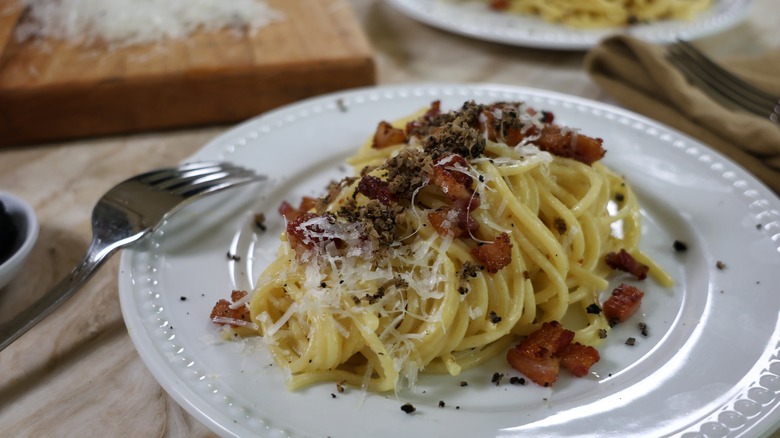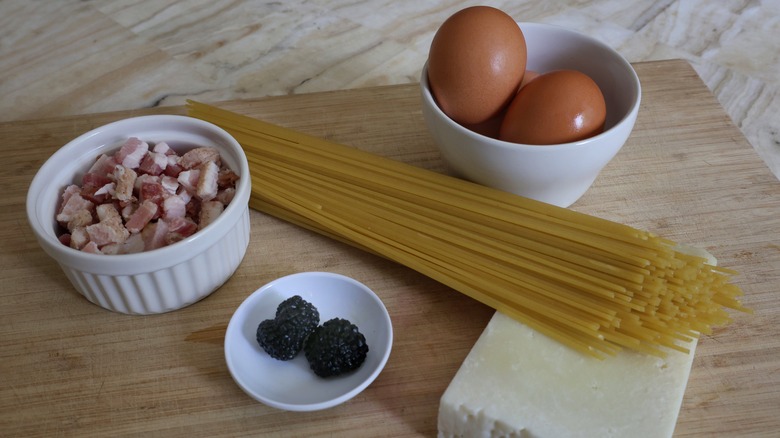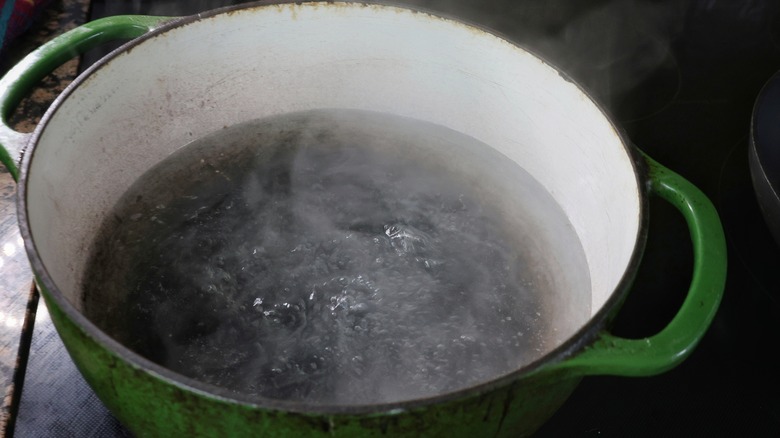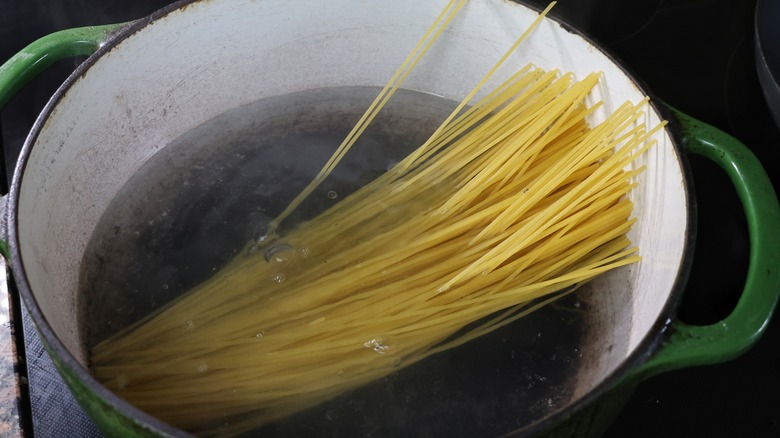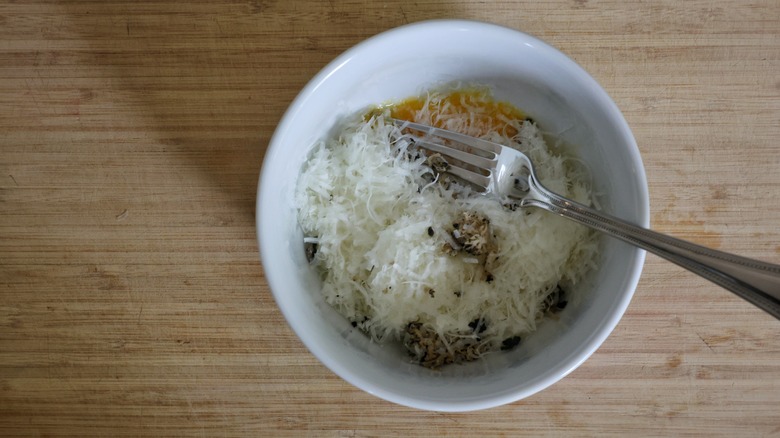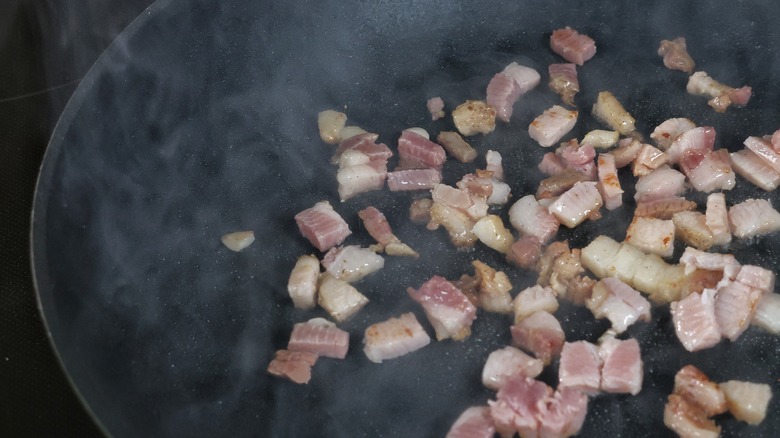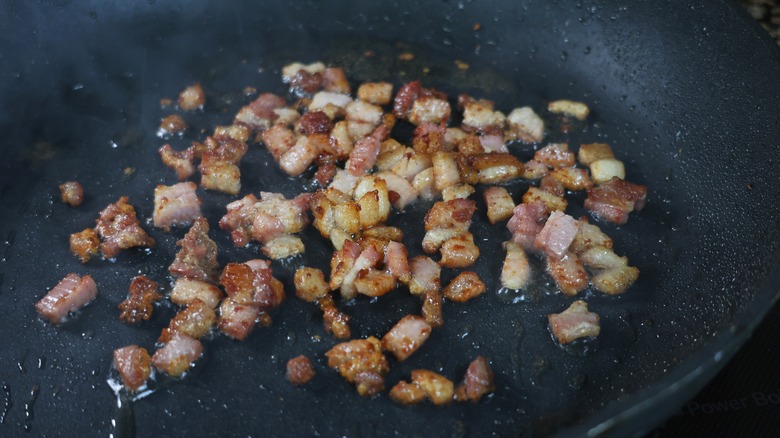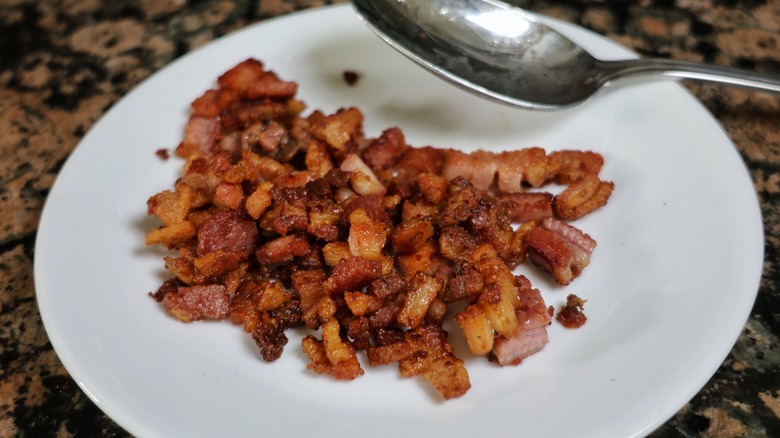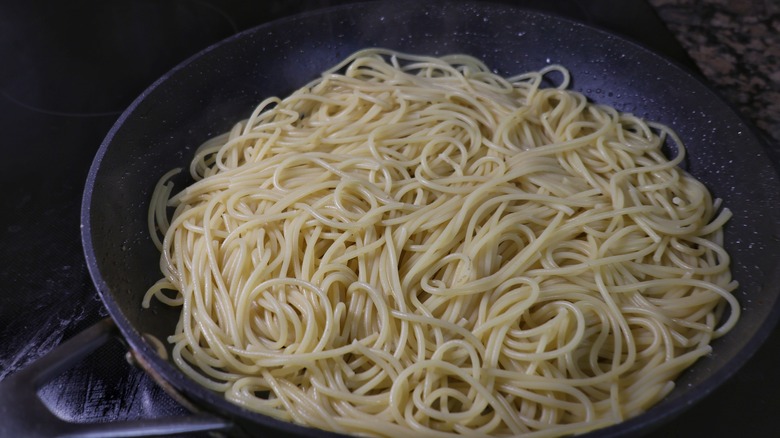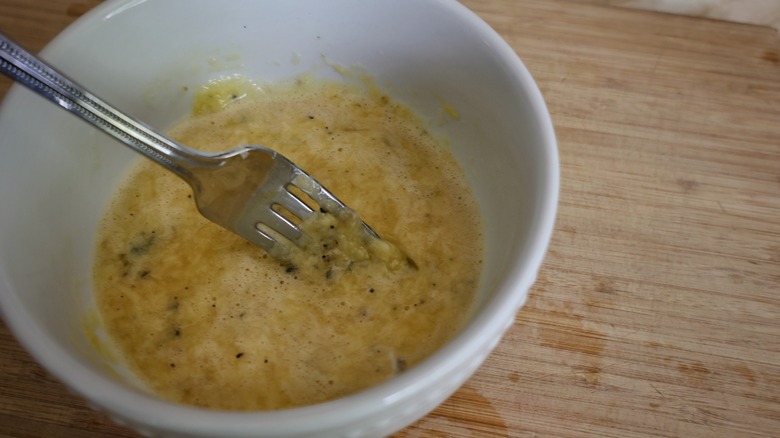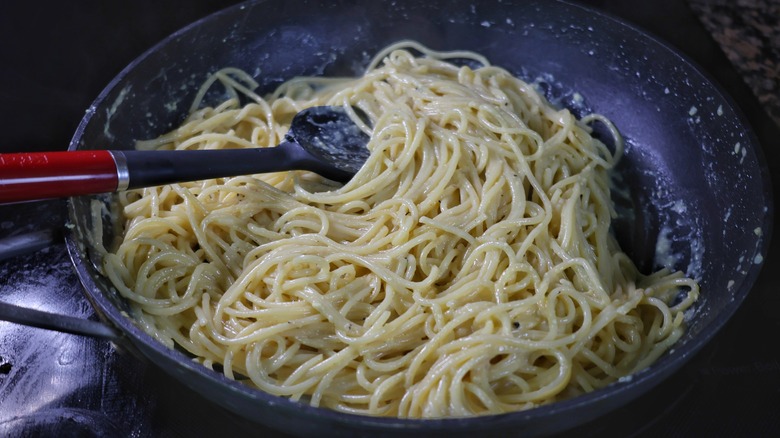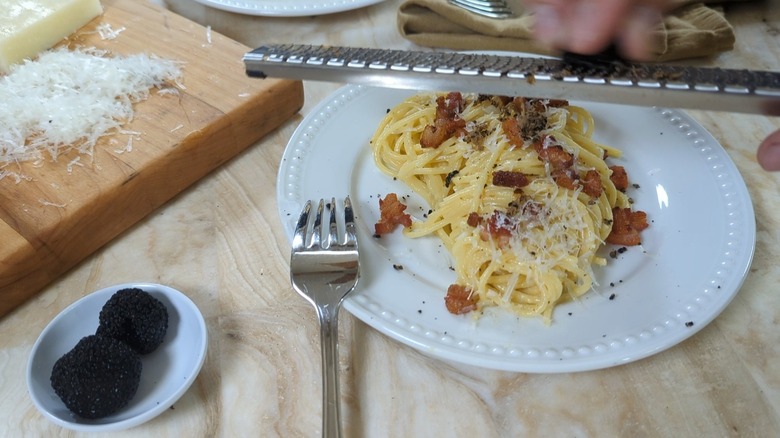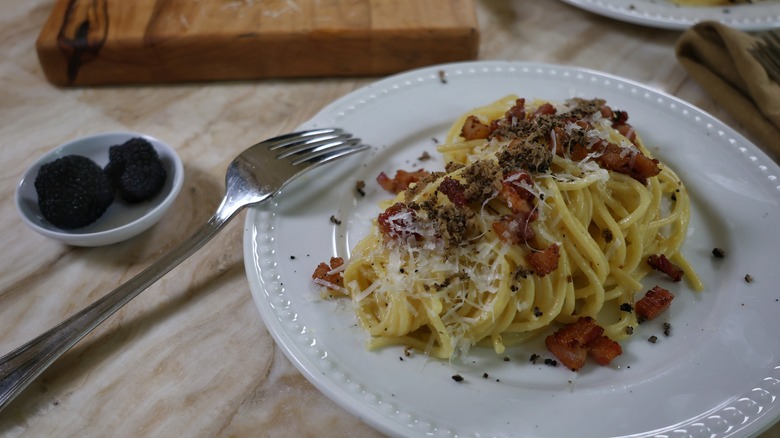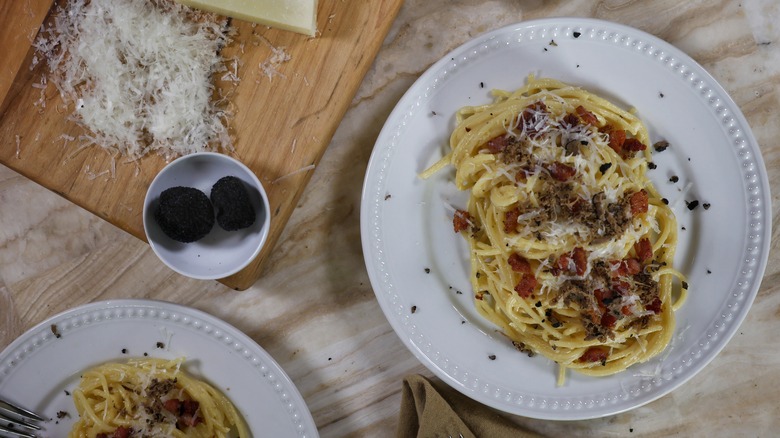Black Truffle Carbonara Recipe
When the occasion is right, and even a traditional spaghetti carbonara, luxuriant as it may be, is not enough to fit the night, this recipe is the perfect solution. The classic dish, pasta carbonara, with its simple, sumptuous sauce, takes on an entirely new life when the intriguing aromas of black truffle are introduced. There may be no better match for a silky carbonara, rich with the salty flavors of pancetta and pecorino, than the earthy, musky perfume of a ripe black truffle.
Truffles are an irresistible and somewhat unique in the fungi that we eat. Not only are truffles among the most prized fungi, but the harvesting of these wild ingredients is also quite different. Most fungi in the kitchen come in the form of mushrooms, large fruiting bodies that appear aboveground. Truffles, on the other hand, hide under the earth, relying on their intense scent to lure us in. It is the unique underground life-cycle of truffles that has bestowed them with such a strong and desirable aroma.
While no good truffle dish comes without a sizable price tag, there is a reason the unique aromas of truffles have been a culinary mainstay for centuries. This is not an everyday recipe, this is something to keep in your back pocket for the perfect night. Whether it is a long-desired date, a romantic anniversary, or simply a meal that you don't wish to forget, this recipe will be there when you need it.
Gather the black truffle carbonara ingredients
For this recipe you will need spaghetti, pancetta, pecorino romano, eggs, and, of course, black truffles. Once you have gathered these ingredients together, you are ready to start cooking this delicious, luxurious meal.
Step 1: Boil water
Bring a pot of well-salted water (around 1 teaspoon salt per quart of water) to a boil.
Step 2: Cook the spaghetti
Add the spaghetti and cook until al dente, around 10 minutes.
Step 3: Whisk together the sauce ingredients
Add the egg yolks, egg, ¾ cup pecorino, and 1 tablespoon grated black truffle to a bowl and whisk until well-combined. Set aside.
Step 4: Start the pancetta
Bring a skillet to medium heat and add the pancetta.
Step 5: Fry until crisp
Fry the pancetta until crisp on the outside but still tender in the center, around 2 minutes.
Step 6: Remove to plate
Remove the pancetta to a plate.
Step 7: Add spaghetti to skillet
Scoop the cooked spaghetti from the pasta water into the skillet, and cook for around 2 minutes, until almost all of the water is cooked off.
Step 8: Temper the eggs
Slowly pour ¼ cup pasta water into the egg mixture while stirring, to temper the eggs.
Step 9: Sauce the noodles
Once the water is cooked off the pasta, remove from heat and slowly add the egg mixture while stirring the noodles. Stir until it forms a nice, glossy sauce.
Step 10: Garnish and serve
Divide the pasta between two plates and sprinkle over the pancetta as well as the remaining pecorino and black truffle. Add black pepper to taste and serve immediately.
Black Truffle Carbonara Recipe
The only thing more decadent than regular carbonara? This black truffle carbonara, which comes with truffle goodness both within the pasta and on top.
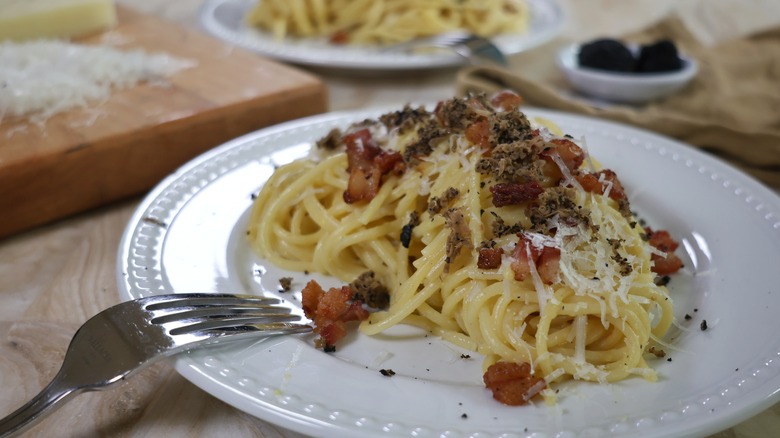
Ingredients
- 8 ounces spaghetti
- 2 egg yolks
- 1 egg
- 1 cup grated pecorino Romano, divided
- 2 tablespoons grated black truffle, divided
- 3 ounces pancetta
- Ground black pepper, to taste
Directions
- Bring a pot of well-salted water (around 1 teaspoon salt per quart of water) to a boil.
- Add the spaghetti and cook until al dente, around 10 minutes.
- Add the egg yolks, egg, ¾ cup pecorino, and 1 tablespoon grated black truffle to a bowl and whisk until well-combined. Set aside.
- Bring a skillet to medium heat and add the pancetta.
- Fry the pancetta until crisp on the outside but still tender in the center, around 2 minutes.
- Remove the pancetta to a plate.
- Scoop the cooked spaghetti from the pasta water into the skillet, and cook for around 2 minutes, until almost all of the water is cooked off.
- Slowly pour ¼ cup pasta water into the egg mixture while stirring, to temper the eggs.
- Once the water is cooked off the pasta, remove from heat and slowly add the egg mixture while stirring the noodles. Stir until it forms a nice, glossy sauce.
- Divide the pasta between two plates and sprinkle over the pancetta as well as the remaining pecorino and black truffle. Add black pepper to taste and serve immediately.
Nutrition
| Calories per Serving | 723 |
| Total Fat | 26.9 g |
| Saturated Fat | 10.1 g |
| Trans Fat | 0.1 g |
| Cholesterol | 268.2 mg |
| Total Carbohydrates | 87.5 g |
| Dietary Fiber | 5.0 g |
| Total Sugars | 3.4 g |
| Sodium | 566.6 mg |
| Protein | 30.2 g |
What is the difference between black truffles and white truffles?
Truffles are often talked about as if they are a single food item, a single ingredient, so you may be surprised to learn that there are actually many different types of truffles, coming from different regions in the world and bearing different and unique flavor profiles.
The largest divide in the truffle world is between white truffles and black truffles. Upon first glance, it is hard to imagine that these two fungi would be considered in the same class. White truffles look something like a lumpy white potato, while black truffles are dark in color, with a heavily textured exterior. It is only when you take in the aroma that they begin to seem alike. But here too, there are significant differences.
White truffles are the more fragrant of the two, with an intense aroma that does not stand up well to heat. For this reason, they are typically used as a raw garnish, shaved over the top of a dish to add their irresistible perfume. Black truffles, on the other hand, are slightly less aromatic, but hold up better to cooking, though both are better when handled only gingerly in the kitchen. White truffles also typically command a much higher price than their darker counterparts, their increased pungency and short shelf-life contributing to a price tag that can put them out of reach of many home cooks.
Can I use preserved truffles for this carbonara recipe?
Truffles are generally both an incredibly expensive and incredibly short-lived ingredient. In recent times, we have seen both the advent of truffle cultivation and the spread of truffle harvesting to all corners of the globe. With the increased desire for, and availability of, truffles across the globe, we have also seen the rise of many varieties of preserved truffle products, some of them better than others.
If prepared properly, preserved or canned truffles can be wonderful, but you must be wary when it comes to purchasing preserved truffle products. There are many truffle products out there which, despite using the word truffle in their name, actually contain none of that favorite fungi. Truffle oils tend to be the worst offenders, with many of these products relying instead solely on chemicals which mimic truffle aroma.
There are however many quality products out there as well, which derive their flavor from real truffles. With such a prized and expensive ingredient as truffles, it is important to do your research. The last thing you want is to spend the money and build the anticipation, only to end up with a dupe.
